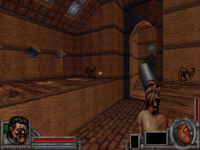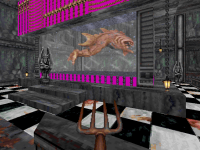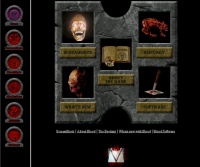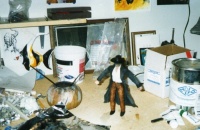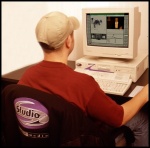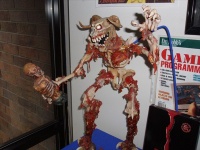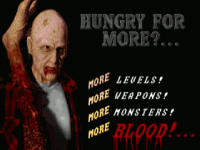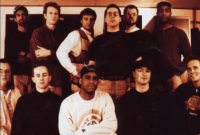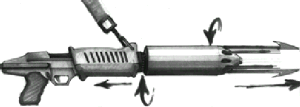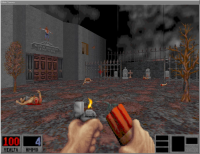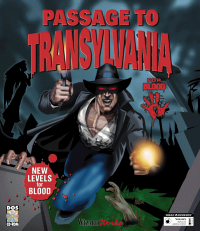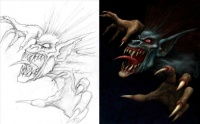Development of Blood
"Speculation about how Blood came about has been amusing to those of us who lived it." — Nick Newhard, 2014
Article outlining the history and process of the development of Blood and its expansions Cryptic Passage and Plasma Pak.
History[edit]
"Blood was finished by the same team (albeit larger) that start it. Nick and I formed Q Studios in 1993 (originally as Apogee West), and we were acquired by Monolith (which was formed by some former colleagues of ours from Edmark) in 1996-1997. So, how would have Blood been different if it had been finished by Q Studios? No different at all, really, it was the same team completing it (although I left Monolith for personal reasons before Blood actually shipped). Over the course of development, Blood changed many times, and each change was for the better. One of the benefits of small development teams is that they can adapt and iterate on their design fairly quickly without being locked into a rigid plan." — Peter Freese, February 19, 2011
Conception[edit]
"I approached Scott Miller and George Broussard of Apogee with the idea of forming a development team in Seattle. There were a lot of negotiations and the end result was that our team, Q Studios, was incorporated into Apogee with the goal of developing Blood - a first-person shooter using the Build Engine... It was a real 'garage start-up', although actually it took up my entire family room and two bedrooms. I was recently married and my wife was thrilled at the idea of having a games company in the house with employees there at all hours. All joking aside, Helen [Newhard] was a real peach about it and even pitched in as a bookkeeper and late-night playtester." — Nick Newhard, 2014
The initial conceptualization for Blood started when Nick Newhard worked at Edmark Corporation, with him bouncing ideas around with co-worker Jason Hall about a fantasy game ala Gauntlet (similar to Monolith's later Get Medieval) only in 3D. The idea was to develop a networked game that would be PC-based but run in arcades. They decided to look into pursuing the idea on the Build engine, being developed since March 1993 by Ken Silverman under the patronage of Apogee Software. Apogee gave the project their support, and began efforts to start a new development office on the American west coast ("Apogee West"), which eventually became QStudios in November 1994.
However, the money provided did not stretch very far, so Newhard initially began work on the project on his own, with some assistance from artist and friend Chris Rush until late spring 1994. Hall meanwhile remained at Edmark and later helped found Monolith Productions in October 1994. Since another Apogee team was working on a fantasy game on the Build engine (Ruins: Return of the Gods, later sold and re-branded as PowerSlave; Witchaven, the first released Build engine game, was also fantasy based), it was decided to restart the project as "Horror 3D" in early 1994 as a shareware release. According to a 2014 article, other early story ideas for the game included a man escaping from a secret government lab or someone avenging their family's deaths at the hands of alien demonic forces. Soon joining Newhard was programmer Peter Freese, first as a freelancer before finally starting full-time in October 1994.
Apogee supplied more funding, and allowed them to hire Kevin Kilstrom as a staff artist in June-July 1994, as well as artist Eric Klokstad between July and October 1994. Development continued based from Nick Newhard's family room, often suffering in the summer heat, although with easy access to a neighbouring park. Impressed by his Doom custom mapping, Apogee founder Scott Miller hired James Wilson III in August 1995 as an additional mapper, moving him from Boston to Seattle and replacing Richard Gray, who was similarly recruited in September 1994. It was during this prior period that Gray acquired his signature "Levelord" based on how he signed e-mails to Nick Newhard. Gray's March 1995 transfer to the Duke Nukem 3D team played a role in the later estrangement between Monolith and 3D Realms, as Apogee morphed into in 1996. Additional artist and level designer Terry Hamel was hired earlier in June 1995. Level designer the late John "Dr. Sleep" Anderson listed on his resume involvement in Q Studios from August 1994 to August 1995. 3D Realms described the Blood development in a 1995 version of their official FAQ:
"Blood was originally conceived by Nick Newhard in late 1993, with the idea of being something like a 3D Gauntlet-style game. Nick was researching 3D engines at the time and decided to leave a programming position at Edmark Corporation (developing educational games) to begin work on the project with Chris Rush, artist and longtime friend. Nick's idea was to develop a networked game that would be PC based and run in arcades. A deal was made with Apogee to work on the game and set up 'Apogee West,' a West coast division of Apogee that would recruit and work with local talent. In the spring of 1994, the situation changed somewhat as Apogee/3D Realms decided they wanted Nick to work exclusively on the project rather than setting up Apogee West. By this time, the game had moved to being a shareware release and the concept had taken on a horror theme. Peter Freese began working part-time, doing some of the programming. In late spring, Chris Rush left the project. Throughout the summer, Nick and Peter began discussing the formation of a company. In July, Kevin Kilstrom and Erik Klokstad, both artists, were hired. In October, Erik left, and Peter started working full-time. Q Studios became incorporated in November 1994. Artist Terry Hamel was hired in June 1995 and level designer Jay Wilson (aka 'Shade') in August. The music and sound effects will be produced by LoudMouth." — "The Official 3D Realms FAQ, November 15, 1995
At some point during the game's development there was a leak onto the Internet of the Blood source code by an employee at a computer repair shop, dated February 17, 1996, which was reacted to severely by the game's publisher (on Newhard's birthday no less). Eventually Monolith settled the case in court, but the released files became known to the community as the Blood Alpha. The developers later made it policy that a staff member was to accompany computers to repair and monitor the repairers at all times. This early demonstration contains several differences from the released game, including Caleb as a robed fanatic named Michael; his character was later greatly expanded by his actor Stephan Weyte.
Start of Weekly Updates[edit]
"And speaking of release dates, the Official Word from 3D Realms is 'When it's done.' We appreciate all your mail with questions and comments about Blood, but please don't inundate us with e-mail asking us when the shareware version will be out. The game will get done when it's done and will kick ass over every other 3D multiplayer/network games. Just let us keep on working and providing weekly updates and we'll all stay happy." — Blood Weekly Updates - September 20, 1996
After the successful release of Duke Nukem 3D in May 1996, development progress was made public starting in June 1996 with weekly updates on first the 3D Realms (by career webmaster Joe Siegler) and then later on the official Blood website. The development team expanded throughout 1996 to include 3D artist Brian Waite in July, level designer Craig Hubbard in August, and artificial intelligence programmer Daniel Leeks in October. June 1996 also saw the addition of the game's 3D sound system (adapting work by Jim Dosé) and the completion of the MapEdit and Setup tools (including porting to Windows 95), while July saw the additions of the first voxel graphics ("a new technology that kicks ass over plain old polygons") and the integration of simulated room-over-room. Spencer Maiers also began work on the game's website.
That same month Q Studios moved offices (or rather, moved to offices), beginning the merger with Monolith Productions under the purview of new project manager Matt Saettler, reuniting Newhard and Freese with Jason Hall and other former Edmark colleagues and bringing Craig Hubbard onto the team (tasked with further fleshing out the game's backstory). The merger was partially motivated by the desire to add in 3D cutscenes, something which required the infrastructure that Monolith Studios provided, as well as acquiring more resources to finally finish the projct. Peter Freese left the team for personal reasons soon after the merger into Monolith.
August 1996 saw the addition of the Hall of the Epiphany, the introduction of an ultimately dropped creature known as "The Fly", and the Hell Staff weapon. The company also held a jet-ski party and a "Death Day" deathmatch; three game company anagrams were also placed in the updates. September witnessed the completion of the Innocents, the demand that the entrance of cheat codes be visible to other player's via the chat system, modifications to the weapons and armour, and the final visit by Ken Silverman; Nick Newhard and Kevin Kilstrom also announced their wives' pregnancies (both Helen Newhard and Francine Kilstrom are thanked in the game's credits, as well as James Wilson's then fiancée Lauren Johnson and Matt Saettler's wife Lisa Sheets), and the game was formally given the now infamous release date of "when it's done" first attributed to John Carmack.
A cold struck the developers in October 1996 starting with James Wilson, although work still continued sporadically on levels, with Craig Hubbard completing designs started by Gray for "E2M2: The Lumber Mill" and Wilson adding attractions to "E1M4: Dark Carnival". Work also commenced on the network layer based on the initial efforts of Mark Dochterman; artist Kevin Kilstrom was unaffected by the disease, and started work on the creation of Caleb in his modern form. November ushered in a game buying spree, with the Monolith staff enjoying the original Tomb Raider as well as Command and Conquer: Red Alert. They also completed much mapping work, tweaks and finalization. Daniel Leeks worked on improving the AI for the enemies, "exacting revenge" on Wilson and Hubbard for their superior Bloodbath prowess in the process, as well as adding in creature sounds. An interview was also released with Newhard and Wilson on November 11, 1996 by Online Gaming Review.
Early December featured debates about the balance of the Voodoo Doll in multiplayer instigated by Jason Hall, much sprite work by Kevin Kilstrom, the addition of swimming to the Cultist AI, as well as the first outsider to see and play the beta version of the Blood shareware, soon to be followed by other outside beta testers.
Split from 3D Realms[edit]
"From experience, every game development runs into issues. Blood started with a small development budget, insufficient development tools, a small and partially inexperienced team that had never built a game together, constantly changing requirements from the (original) publisher, an external programmer [Ken Silverman] with an unfinished engine in development…and that's just the start. Any game development team could point to a couple of those things and say, 'Yeah, I've been through that.' We just happened to have them all." — Nick Newhard, April 2008
The first mention of talks with GT Interactive was in November 1996. The December 16th update was the last posted onto the 3D Realms website, while the Blood website updates overlap from August 1996 until then. Late December updates mention work beginning on converting the physical player and enemy models into digital 3D models for the cutscenes, as well as general efforts to bring the game's artwork and interface up to release standards, whilst battling with the wintry weather.
Blood officially entered the beta stage at 4:00 AM on January 2, 1997, with the executable now accessible as the Blood Beta. Communication between the team at Monolith and GT Interactive producer Rick Raymo heated up (including a Bloodbath between Raymo and Hubbard) in anticipation of the shareware release, as well as the final severing of ties with 3D Realms (now focused on completing Shadow Warrior) after a full buyout by Monolith. The reason for the split has been attributed to various personal and professional disagreements between the two parties, including the development direction of Build under Ken Silverman, mostly pertaining to revision control and code co-ordination, as well as complaints regarding the lack of a formal contract and disputes over negotiations for video game console ports (the original Q Studios website mentions plans to port to the Sony Playstation and Sega Saturn). The changed status was announced in a January 22nd press release. James Wilson III later remarked:
"This was due to the fact that we had a very different view of what the game should be than 3D Realms, and we were constantly doing a balancing act of satisfying ourselves and them. Often, 3D Realms would not see the game for months, then we would get an e-mail asking us to completely change a major aspect of the game we had already put a lot of development into. It is not that we were right and they were wrong, we just had different opinions and a difficult time negotiating them. This eventually led to us buying back the rights to the game. Do not get me wrong; I have a great opinion of 3D Realms and their games, but sometimes too many cooks...." — James Wilson III
Peter Freese has also described how the Q Studios team struggled under the limited budget proivided by 3D Realms.
"We never had enough money to do all the things we wanted to do, and our entire budget from 3D Realms was something like $15K a month at its peak, with which we had to pay our entire team and operating expenses. The tight finances put a huge strain on everyone involved and we constantly looked for other sources to help fund the development." — Peter Freese, 2014
Scott Miller has described it merely as a divestment due to taking on too many projects.
"We sold the rights for the simple reason that as we grew our own internal development we simply had too much on our plate, so we had to sell the rights to Ruins, Blood and Descent. Apogee kept Duke Nukem 3D and Shadow Warrior, plus we had other projects underway." — Scott Miller
January saw the introduction of the "humiliation" mode into Bloodbath by Nick Newhard, the final iteration of the Tchernobog model, the writing of voice-over scripts for Stephan Weyte and Jason Hall (and presumably the game's recording sessions), the finalization of "E2M5: The Haunting", general bug fixing, and much play of Diablo (save for, notably, by Daniel Leeks); also shared was an anecdote pertaining to the drainage of Nick Newhard's house. February 1997 featured the creation of the Monolith logo movie and the game's pre-rendered cutscenes under the direction of animator Aaron Carlson, as well as the introduction of revision control, the addition of CD audio, the birth of head kicking (as well as other gibbing/destructibility), the transformation of gargoyles from statues, and the ability for monsters to open doors.
Final Release[edit]
"Even several months before the expected shareware release of Blood, we are amazed at how much this game has evolved from the project we first imagined. When we submitted our initial game design proposal to Apogee in 1994, we had no idea that the talented team of programmers, designers, and artists we'd put together would create a game that surpassed our wildest hopes." — Blood Website
The completion of the first shareware release candidate was achieved in February, with previews soon after released by GameCenter and also by GameSlice (teaser video). The release candidate also received a very strong recommendation from the gaming show Video Masters (YouTube). The finished shareware version was finally released on March 7, 1997, appropriately timed for the birth of Nick Newhard's son Daniel Lee. That same month Jason Hall was interviewed by The Adrenaline Vault (no copy still exists), work continued on the sound engine, patches were released for the shareware, and the offices were rearranged and renovated. The shareware was immediately met with a positive response, being downloaded more than 110,000 times on GameCenter (though Newhard later expressed regret that the interest in the feature rich shareware did not fully translate into retail sales). It also contained several differences, such as delirium mushrooms and a different theme.
April saw the final additions and touches to the retail levels, as well as the marriage of James Wilson to his wife Lauren Johnson with a two week honeymoon in Scotland. Daniel Leeks completed the AI routines for Tchernobog, Kevin Kilstrom finished the last of the art changes for the game, and the sound effects and CD audio reached their culmination under the lead of composers Daniel Bernstein and Guy Whitmore. The month concluded with the transmission of a retail release candidate to GT Interactive, as well as the integration of various online gaming services. Another interview with Newhard and Wilson was also released by oZone on April 19th.
The last development updates from May 1997 speak of the game going gold on April 25, Craig Hubbard working on "Metal Tek", Kevin Kilstrom's work on Claw, the Blood release party, and the commencement of work on the Plasma Pak by James Wilson, Daniel Leeks, and Kevin Kilstrom, with contributions by Craig Hubbard. Blood was also exhibited at the 1997 Electronic Entertainment Expo in June, and Monolith hosted a "Blood Halloween Giveaway" in October 1997. In November 1997 Nick Newhard posted about work on a patch for Blood supporting the Glide API for 3Dfx cards, with an alpha released in March 1998. This was later refined further by the Glidos project.
In the file MONOLITH.TXT included with the game's CD-ROM Jason Hall imparted some final thoughts:
"As with any game project being built, there were tons of things the Blood team would have loved to add. Time being the deciding factor in all cases, they only were able to add some of these things. I would personally like to thank them for making the tough decisions. The cool features that didn't make it into BLOOD will go into BLOOD 2..." — Jason Hall, MONOLITH.TXT on the Blood CD-ROM
Designer Nick Newhard looked back on the game in April 2008 with pride.
"I'm not sure if Blood influenced the gaming world or the other way around. We really made a gamer's game. The AI in Blood could be really difficult to beat. To this day, our Bloodbath mode was the most frenetic and fun multiplayer modes I've ever experienced. If anything, frenetic game play, pop humor, and attention to detail - the hallmarks of Blood - may have influenced later FPS efforts. Blood was the hardest game to develop, yet we made it against nearly insurmountable odds. I handpicked the core team and they have all gone on to do great things. For that, I'm most proud." — Nick Newhard
He elaborated further in a 2014 interview, stressing the game's nuanced gameplay.
"Blood stood out for a number of reasons, starting with its core gameplay - single-player and bloodbath. I'd also point out the attention to detail throughout the game. The movement was tight, the single-player levels were huge and fun to explore, the weapons, alt-fires, positional audio, special effects... all of that plus the great gameplay... It was my 'first child' and years of effort for a small and dedicated core team that worked tirelessly on its release. And we really made a gamer's game and to this day our Bloodbath mode was the most frenetic and fun multiplayer mode I've ever experienced." — Nick Newhard, 2014
While lead level designer James Wilson had this to say during the sequel's development.
"Blood is, as far as I am concerned, the fastest, best, and most satisfying deathmatch of any 3D action game. Monolith is filled with hard-core gamers, people who deathmatch in Doom 2 every day and refuse to play a map other than level one because they are still "perfecting their game," and Blood is still the most played multiplayer game around here. I am also proud of my levels. Blood was my first professional product, and all the reviews were very complimentary of the levels, so this was obviously very gratifying ... I also think Blood was too hard in single player. A challenge is great, but the game did not have any options for beginners, and I think that went a long way towards alienating some people. The difficulty levels in the sequel will have a much greater variation; Hard will certainly be hard, but Easy will be designed for beginning players." — James Wilson III
Even Apogee meanwhile has continued to appreciate the accomplishment of their erstwhile partners.
"Apogee was also responsible for two other award winning games, Descent and Blood. During the development of Descent we sold the rights to Interplay, and during the development of Blood we sold the rights to Monolith Studios." — About Apogee
Newhard would again work with Peter Freese, and Monolith co-founder Toby Gladwell, at start-up Secret Lair Studios in 2006.
Design[edit]
"The best part of Blood's creation really was the team synergy, despite the ups and downs that come with game development. Breaking the back of that beast - completing the game - was an extraordinary accomplishment for a team with several members new to game development. Bathed in Blood, you might say." — Nick Newhard
Themes[edit]
Blood started life as "Horror 3D", and was originally intended to be a far darker and more serious experience:
"The original concept [for Blood], a horror theme written by me and a friend, was far more Lovecraftian in nature and very dark. George Broussard asked us to lighten it up with more humor. We started with a major rewrite of the theme but adding humor to the game was a process that continued throughout development with significant contributions from each new team member." — Nick Newhard
"We put lots of effort into creating an atmospheric, absorbing world full of tricks and traps and even a dose of macabre humor." — Nick Newhard
"HP Lovecraft was definitely a design influence throughout, and the original design for Blood - one gamers never saw - had a much darker and more serious plot. We all planned for Blood to be a serious horror game, hence the 3D sound. And we spent a lot of time coming up with ideas to immerse the player and scare the crap out of them." — Nick Newhard, 2014
Even with the added humour, some emphasis was still placed on creating a sense of palpable tension for the player:
"A good horror atmosphere relies on surprise and anticipation, which is sometimes opposed to the "hordes of monsters" idea of most good action games. Players can expect both in Blood. One moment they'd be walking down the dark halls of an eerie old mansion, a board might creak as an audible footstep is heard behind the player. The player spins around and nothing's there. A few moments later he could be fighting legions of the walking dead with a shotgun in each hand." — James Wilson III
All in all, effort was made to create a balance between the two halves:
"We've tried to strike a balance of extremes in Blood's gameplay. Single-player mode is a dark, haunting, and dangerous atmosphere created by the realistic levels and creatures that inhabit them. Bloodbaths are more fast, furious. I guess what I'm saying is that it's the play that is humorous, not just one thing like comments made by the character." — Nick Newhard
A design staple that remained throughout the game's development was a commitment to producing a graphically gory horror game.
"From my earliest discussions with George and Scott we never wavered from the goal of making the game as graphic as possible, and we never got much flak for it. Games like Postal drew way more attention form uptight politicians like Senator Lieberman, so perhaps the dark humour was our saving grace." — Nick Newhard, 2014
The game's setting, although dated back to 1928 in Blood II, was kept somewhat ambiguous and melded during the game's development. All of which factors into anachronistic elements present in the game, such as the Aerosol Can exhibited before the widespread production of hair spray, as well as futuristic elements present in the Tesla Cannon and Remote Detonators. The Cabal also seem to use bombers in E3M2: The Siege. Levels often featured a Victorian or Edwardian architectural style.
"You're not just good versus evil. You're evil trying to fight a bigger evil. There's no specific time frame. The setting combines the futuristic with a different, supernatural, industrial revolution. It also has voodoo in it." — Nick Newhard
Developers focused on trying to achieve a more cohesive experience than in other games, with one level flowing into the other and collectively describing a progressing journey (although Dead Reckoning was considered the weakest for this):
"You know, we frequently talked about how some other game's levels just felt tacked together. Our goal was to lead the player through levels experiencing a story while feeling like they had actually been somewhere. We never wanted them to say "Hey! Yet another lava level…" Ultimately, Jay and Craig were responsible for putting the level progression list together and they did a great job." — Nick Newhard
Blood drew from many influences, with ideas coming from every member of the team; Kevin Kilstrom was particularly influential in adding the dark humour to the game, while Craig Hubbard was brought in late on to deepen the game's storyline.
"We were all products of our youth and many of those influences made it into Blood. In part, much of this stuff just leapt out while we were playing the game. Someone would say something and it would make it into the game. Kevin Kilstrom was probably the biggest influence in the humor and horror area. The guy kept all of us in stitches and could always be counted on to joke about something." — Nick Newhard
"It probably helped that Kevin was a big fan of Bruce Campbell and had the film Army of Darkness playing repeatedly in our tiny office space! We would regularly watch horror movies at Q Studios, so avoiding cross-contamination form all those flicks was impossible. Often the process began with Kevin, he'd mention a quote or joke that had us all laughing, and next thing you knew something from the movie made it into a sprite, game text or level." — Nick Newhard, 2014
The developers also kept a close eye on the other 3D action games then on the market:
"It's a constant worry. There is always a twinge of disappointment when we see a new game come out that has a feature that previously only we had, but ultimately all of us on the team love 3D action games, and we all have this idea of what the ultimate one would be like, and fortunately I feel we've hit the nail on the head with just about every part of Blood." — James Wilson III
"Very late in production we were playing the capture the flag mod in Quake, and we found it so engaging, we spent the next 36 hours coding it into Blood." — Nick Newhard, 2014
Weapons[edit]
Following on the success of id Software's landmark Doom, the developers were keen not just to match but surpass that title:
"Two things have prevented most 3D action games from becoming hits. First, most of them do not have the right feel for an action game. Most devout Doom deathmatch fans will tell you that the greatest thing about Doom and Doom II was the feel of the game during a deathmatch. We approached Blood not wanting to make a clone, but to make Blood's gameplay superior to the rest of the market. Part of it is in the solid, almost organic feel of the controls, but our arsenal also plays a big role. Not only are our weapons well-balanced, they're also very distinct and versatile. In a typical BloodBath, players will end up using most if not all of the weapons, because each has a different tactical advantage. That sort of intricacy is missing from a lot of other games, where you tend to stick to the most powerful gun." — Nick Newhard
They drew from a variety of sources when envisioning Caleb's arsenal:
"Inspiration for Blood's weapons came from a number of places. We considered renting a conventional military flare/grenade launcher. We researched several models, but none of them fit Blood's theme or character." — Nick Newhard
"I wrote up a bunch of ideas for weapons Caleb could acquire during the game, and added improvisational ones such as the lighter/spray can." — Nick Newhard, 2014
Varying firing modes and other touches were added to ensure that every weapon would have utility in both single player and multiplayer:
"We added our own ouches to the weapon to increase the carnage level caused by the various firing modes. While there is no real life equivalent to the startburst flare pattern, it ensures that Blood's flare pistol is unique, balanced, and noteworthy in both solo and network play. There are plenty of games where you ignore the 'special' weapons because they suck. There is not one weapon in Blood that that can be said about. The thrown TNT is probably the weakest BloodBath weapon, but I have seen scores of 'good' players being reamed by Monolith's best players using TNT. To enhance TNT as a weapon, we added TNT Proximity Bombs and TNT Remote Bombs to the retail and registered versions of Blood. These weapons are excellent tools for BloodBath destruction. I suppose I can take credit for the Voodoo Doll concept, but it was Kevin Kilstrom's artwork and the team's suggestions that made the Voodoo Doll a truly great weapon." — Nick Newhard
"On the weapons front we've given lots of our weapons and power-ups dual functionalities. The Voodoo Doll, for example, is very effective against zombies (disintegrates them!) and does a good job of taking down monsters from a distance. In multiplay, it is the ultimate sniping weapon, relatively undetectable, doing fair damage, and causing adverse effects like blindness (eye shot) and weapon holstering (shoulder shot)." — James Wilson III
Game Balance[edit]
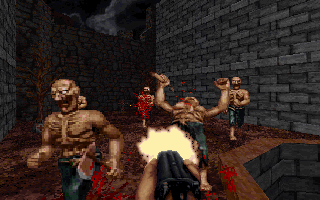
Balance in Blood was achieved through both extended play testing and attention to detail:
"My greatest contribution was persistence and iteration. If something wasn't right I either made it right or pushed hard to make it right. We played the hell out of the game from the earliest builds and no one held anything back if a game element didn't feel right. The team had a pretty heated week-long discussion over game physics and realism vs. exaggerated presentation. Ultimately, we ended up with the best of both worlds." — Nick Newhard
"We're aiming towards a well-proportioned mix of atmosphere with action ... Maximizing both the horror and action elements of the game are our main concerns. We're putting in a lot of work on the play-balancing of the levels to make sure that it never becomes a simple shoot-em-up with tons of monsters around EVERY corner, but rather tons of monsters in places where it scares (and hurts ) the most." — James Wilson III
This balance was applied to both the single player and multiplayer game modes:
"A lot of attention has been paid to both. They definitely have a different flavor, though. Single player games are heavier on atmosphere. There are plenty of things to kill, but we've tried to get that "surviving by the skin of your teeth" feel to it that encourages a little caution and intelligence in how you proceed. Our multi-player games are nothing short high-speed mass destruction. The player with the quickest guns and biggest appetite for death will prevail here. We've tried to split our levels up to compensate for both, providing, many levels that are tighter and smaller than almost anything you'll find in [Duke Nukem 3D] and balancing that with really large single player levels. As a result we may end up having a few more levels than [Duke Nukem 3D] did, but most of those extras will be very small levels intended (and THOROUGHLY tested) to be great multiplayer maps." — James Wilson III
The game was also unusual for increasing weapon and enemy attribute values, as well as just their frequency in game, in higher skill levels. Higher skill levels were also increasingly balanced with cooperative play in mind. This was however compromised by a bug caused by loading a save game that often loaded the wrong damage values; corrected in source ports.
"Playing the episodes in order will preserve the flow of the game story and ensure a more gradual increase in difficulty... You must also select a skill level. Blood's skill levels affect more than the number of monsters or powerups you will find along the way-the harder the level, the more damage monsters can take and dish out... Still Kicking is recommended only for beginning players who are easily frustrated or frightened-and even they may be subject to our ridicule. Likewise, Extra Crispy was designed with cooperative play in mind and may therefore seem a bit too challenging to a single player. Not that we expect that to stop you." — Blood manual
The controls were an area of particular consternation for the development team, triggering the worst arguments:
"I think it's safe to say our biggest arguments were over issues related to the controls. I think Blood's control scheme fits both the genre and the market. General player movements speeds are faster than every game - except Duke Nukem 3D. We like the controls in Blood as they are because they fit the atmosphere, the weapons, the opponents, and the levels. The movement and jumping are all silky smooth and feel very solid. We anticipate very little tweaking from here on out." — Nick Newhard
Peter Freese, the game's technical lead, has shared an anecdote on the effort he put into fine-tuning the game's movement in homage to Doom.
"I think I spent two whole days trying to reverse engineer Doom's control acceleration. After painstakingly recording rotational speeds and keyboard acceleration, I implemented what I believed to be a similar system in Blood. I showed it to Nick and he said 'Nope, that's still not right!' Nick was really hard to please when it came to this, but I think it was the right thing to place so much importance on it. There were several Doom clones out while we were in development and many of their controls were just abysmal." — Peter Freese, 2014
The final result was a game where a multitude of systems would work properly in concert:
"Multiple types of damage effects like explosions, electricity and burning (fire flies off the player as he runs around trying to find water to put himself out and stop his health from dwindling any further) all with very satisfying visual and audial results, real physics (you haven't seen the bodies fly until you've seen it in Blood), innovative weapons (Voodoo Doll, Flare Gun, Hellstaff that sucks souls and uses them for ammo), a very interactive environment where bullets even make ricochet sounds according to what kind of surfaces they hit, and more blood than you can shake a pitchfork at all make us feel pretty confident." — James Wilson III
"Aside from the level design, I'd like to think Blood's complete secondary fire modes, guns akimbo, Doppler audio, level secrets, and amazing number of details are also hallmarks of the game. When someone on the team proposed a cool idea, we always tried to find a simple way to fit it in the game." — Nick Newhard
They also were willing to take or implement suggestions for the game from their closed beta testers, including, apparently, head soccer.
"You know, I used to be a beta tester way back when. I actually had two ideas of mine get implemented! The first was to have all the blood that flies splatter on the ground. It unfortunately got removed due to natural conflict of its appearance with the same animation over multiple spots in a row (I assume) with the arterial sprays. The second was to be able to kick around the decapitated heads!!! I swear to god! Me and some programmer are totally responsible for that! :D I'm actually playing the Blood demo right now. I want to see if I can figure out a way (or a compromise most likely) to have at least some of the blood splatter on the ground. Think of the game Primal Rage. In the Genesis version, there was blood. But it didn't splatter. It would just disappear into the ground. In the arcade version, all that blood would splatter into these huge, awesome pools of blood! Imagine Mortal Kombat 1 or 2 without the blood splatter animation. It just wouldn't be the same." — Asphyxium
Unlike Duke Nukem 3D or Heretic, Blood features no modes for flying through the levels. Such an item was considered, termed "raven flight", but was dropped in order not to spoil the game's platforming puzzles; instead Caleb has a rather high jump, which can be extended even higher through the use of jump boots. This idea was carried over to Blood II as a signature hallmark.
"Although the game was originally going to include some variation of a jet pack, the designers scrapped it as they felt the jet pack might remove the need to solve a large portion of the puzzles in the game." — GameSlice preview
Additionally, the Blood Alpha featured an ultimately removed item called "feather fall" which slowed down the player's gravitational acceleration and limited any damage upon impact.
Technology[edit]
In contrast to true-3D technological show-pieces like id Software's recently released Quake or Parallax Software's Descent, the Blood developers focused on refined play on top of the by then out-dated 2.5D Build rendering engine:
"Simply said, Blood runs faster. Working with Build hasn't been difficult, because for the majority of the project Build was the best thing out there. At the end of the day, though, all the true 3D in the world doesn't save Quake from the fact that it is hollow as a game, and merely a shell supported by its technology. Gameplay and content are king, and that's why Duke outsold Quake by a hefty margin. When it gets right down to it, most people don't notice true 3D when they are playing the game, they only notice whether they are having fun." — James Wilson III
This did not prevent Blood from pushing the envelope in certain areas, most notably by exhibiting the first simulated room-over-room on the Build engine (developed independently from the one shown soon after in Shadow Warrior), as well as being the first to ship using voxels:
"The biggest advance in Blood lets us create maps that are truly three-dimensional. The renderer is the same as the one used in Duke 3D, but we enhanced it to allow it to display sectors over other sectors. This technique was later adopted by the Shadow Warrior team. The engine coder recently added another sprite-drawing technique that will outdate even polygon technology used by some of the newer games. Our sprites look more detailed without the square edges found in low-polygon-count sprites in those other games." — "Nick Newhard"
"At some point [Ken] added voxels [into the engine] and we incorporated them once the kinks were worked out and we had the tools to make them." — Nick Newhard, 2014
All of which did allow for more varied level designs than was seen in Duke Nukem 3D or Doom, particularly in terms of verticality.
"It allows our areas to be much more integrated and complex. It's freed us up to be a lot more creative, versatile, and sneaky. In play this means that danger can come from more directions and in more ways, make the environment much more dynamic and exciting. In Blood you can expect a lot more vertical depth than you got in Duke." — "James Wilson III"
"I would put it all to the test in a level, and often ended up with a fantastic-looking area or some really great-looking effect, but not a complete level, and these found their way into larger maps." — Nick Newhard, 2014
The team stressed the use of voxels as a means to compete with emerging true-3D technologies; effort was put in to replace as many sprites as possible.
"Brian Waite has come on part time as a 3D artist. Brian has been modeling tons of items for Blood. Kevin imported them using a new technology that kicks ass over plain old polygons... If we can get Ken to finish the editor for our new game objects, none of the Blood's game objects will be 2D sprites... Kevin continued his mission to eradicate normal sprite items from the game. Almost all items and objects use the new renderer... Kevin reworked more items into the 'better than polygons' technology. We may change some of the hazards like the spike, machine gun and flamethrower traps to the new 3D rendering system too... Maybe [Ken Silverman] will enhance the 3D sprite editor for doing 3D characters while he's here. Keep watching. We'll let you know about any new groundbreaking changes." — "Blood Weekly Updates"
Another stand out feature was the surface attributes added to the engine for substances of varying materials, a feature carried over to LithTech:
"You can destroy anything right down to the signs on the walls. Unlike Duke, we have somewhere in the region of 30 different chip types. Burning wood, regular wood, metal, rocks, plants. Pretty much everything can be destroyed and pretty much everything has its own individual look when it gets wrecked." — Craig Hubbard
There was however some concerns for the lack of flexibility in their technology, with no in-game scripting available beyond tagging points.
"It wasn't the technology that worried the team, but the extensibility of the engine itself. While Quake was being developed as a game engine, the Build engine was really more of a 2.5D rendering engine with some bells and whistles. The Blood team had developed a pretty good system for tagging points and lines for the game engine, we had no scripting language at all so extensibility was limited — in other words, no modding. To make up for that weakness, we focused on fast and fun game play and fantastic level design. Don't get me wrong; Quake was a fantastic game, and if we had it to do all over again, I'd love to have built Blood with a more flexible technology than we had at the time." — Nick Newhard
The game was also something of a throwback for still being tied to MS DOS in 1997, a somewhat ironic point given Monolith Productions' early evangelism for Windows 95 graphics and games. As with the older rendering technology, this was a product of the game's comparatively extended development period.
"Basically, the idea of starting Blood development from scratch for Windows95 did not appeal to the team, to Monolith, or to our publisher. There are plenty of great DOS games that function under Windows95. We realize the future is in game development on non-DOS platforms, but in the case of Blood, chose not to throw out years of work to redesign for one platform. We are looking into the feasibility of supporting hardware acceleration at some point after Blood's retail release - this may or may not occur." — James Wilson III
Blood was later enhanced with 3D acceleration using the Glide API for 3Dfx cards, further streamlined by the Glidos project. Various source port projects have attempted to upgrade Blood to more modern technology such as OpenGL or Direct3D, maturing with BloodGDX in 2017, followed by NBlood and Raze; a somewhat official effort was earlier attempted by Jason Hall in 2012. Atari later green-lit a remaster by Nightdive Studios in 2019 called Fresh Supply that uses their in-house Kex Engine.
Work on the Direct Engine was already under-way internally during the last few months of the Blood development, opening up new horizons.
"If Ken puts his mind to it, he could quickly code several improvements to the Build renderer for future games. It's unlikely we will use Build again simply because Monolith is working on DirectEngine which dramatically surpasses the current wave of game and rendering engines." — Nick Newhard
Bloodlust[edit]
"One of the innovations we conceived early on was the idea of BloodLust. Each time you as the player kill a minion of the Dark God, your BloodLust meter climbs a notch. If your BloodLust climbs high enough, you metamorphose into the Beast. As the Beast, you are stronger and faster than a human, but you are also limited in your choice of weaponry. There's a compromise between raw physical strength and tactical flexibility. Of course, BloodLust wanes with time--if you don't kill frequently, you revert to human form. That way, methodical players can generally progress through the levels without ever taking Beast form, while "kill and collect" types can romp around as Beasts all they want." — Blood Website
While under QStudios, one of the undeveloped features of Blood was that of Bloodlust. With each enemy killed, a Bloodlust meter would increase, until it reached capacity. At that point, Caleb would transform into the Beast, with increased strength and speed, but less choice in weaponry. In order to maintain this mode, the player would have to continue killing, or risk reverting to human form. Although this feature was not included in the final version, the core plot line still centralizes around this idea, as Tchernobog declares his reason for condemning Caleb was that he would return with the power of all the lives he took (this idea also features in the Blood inspired comic Priest). The sprites for this are still included in the game files. The feature was ultimately removed for the fear that, although stronger, being forced to resort to melee attacks would become tedious.
"We sort of had it working, but we actually cut it because it kind of sucked in melee combat and didn't contribute to the fun. It was one of those things that sounded great on paper but failed in gameplay." — Nick Newhard, 2014
Inspiration for the idea is hard to pinpoint, but people have sometimes pointed fingers at George Broussard:
"I don't remember exactly where the original idea of beast mode came from (it might have been me), but I think the impetus behind it was a request by George Broussard to have the player be an evil creature instead of a human ("What if you could be EVIL?!") We played around with a couple of design concepts for it, including implementing a "blood lust" meter -- if you killed enough enemies in a short enough period of time, you would transform into the beast with hugely improved damage resistance and high amounts of melee damage. It was an interesting idea, and Kevin did some great artwork for it, but in the end it wasn't really fun to transition from ranged combat to melee in an FPS." — Peter Freese, February 19, 2011
The feature was still intended to be added right up to the completion of the final retail release:
"In the registered version we'll have a blood-lust mode. After killing a succession of enemies your blood-lust meter will rise and as soon as it reaches a certain point, it will actually transmogrify into a beast-like creature which can take far more damage. At that point you become a close-combat melee creature. Temporarily. Blood-lust will drop and you'll warp back into a human again. But if you keep killing people..." — Nick Newhard
Craig Hubbard described the effect blood-lust would have on Bloodbath games:
"So if one player reaches that stage in a multi-player game with a load of people, everyone will stop and try to take him out, because he will have become so powerful and won't stop killing people. Or everyone will run and hide." — Craig Hubbard
Another dropped feature was the ability to play as the other Chosen, which was included in the sequel (albeit again in a truncated form). Likely, each player would have transformed into a different creature, which seemingly later became Tchernobog's lieutenants Cheogh, Shial and Cerberus. Each of which are responsible for the death of one of the Chosen in the game's opening cutscene.
A mod exists that alters the game's art to allow the player to be the Beast in game, replacing the pitchfork with its claws. A version of this is shipped with the New Alone in the Dark mod as an option.
Cryptic Passage[edit]
"Cryptic Passage was developed after Duke it out in DC. This was the period I had finished my time at UT Austin and getting ready to move to Indiana so I could work for Sunstorm Interactive full time. We wrapped it up the first couple of weeks after I arrived, so most of the work was done remotely from Texas. For this project I was focused on dramatically improving the GAMER program and installer. It became much more flexible and game agnostic, allowing us to use it for all of the add-ons being produced. I also kept my hands dirty in the editor and made a simple deathmatch level called Deadly Inspirations. I don’t have Blood installed so I’m unable to verify that the map even works, but I’m providing it for download for the time being in case anyone’s curiosity is piqued. I don’t remember much about the level, and don’t have any screenshots to provide. As soon as I’m able to track down a copy of Blood and get it to load I’ll post more. The add-on was well received by Blood fans, and is a solid addition to the Sunstorm library." — Charlie Wiederhold
A third-party add-on to Blood was announced shortly before the release of the game's shareware, with the first news post from March 4, 1997 announcing it as Cryptic Passage; it was previously under the working title of "Passage to Transylvania". A teaser for the pack was released on May 29, 1997 and featured the level "Lost Monastery"; the expansion then entered final testing on June 7th. The full version was released on June 30th published by WizardWorks Software. The last news post released by Sunstorm Interactive was on August 28, 1997 and pertained to final bug fixes, most notably a crashing issue among users of Pentium II processors.
The original level names and order were as follows:
- Creepy Boat Docks
- Old Opera House
- Gothic Library
- Lost Monastery
- Steamboat
- Graveyard
- Abysmal Mine Shaft
- Mountain Pass
- Ancient Castle
- Boggy Creek
"I worked on a commercial add on for Blood called Cryptic Passage. But don't ask me how you could get a hold of it. I don't even have a copy myself... I did the mine level, and the the library's exterior and first floor, as well as some technical stuff like making areas over areas and 'subways' work properly. I don't remember if I did anything else for it. The mine level is the better of the two levels as far as gameplay goes. The guy that finished the library level did so in one day, so a lot of the puzzles I'd planned for it, as well as the basement I think, got tossed by the wayside. But the library looks better. I modelled it after a local library which was built in the 1920's or something. Making the second floor visible from the first in the reception area was a real pain in the ass, because with that engine the 'sectors' in areas-over-areas had to be split up just right or you would get a hall-of-mirrors effect from the sector not being drawn. I think the issue was that you couldn't see a vertical slice of the first floor's walls at the same X as a vertical slice of the second floor's walls at the same time." — Shawn Swift
"Robert [Travis] probably took over after that point. I think he finished the remainder of the map in a day, creating the whole of the attic on his own. I was running behind and he was really fast. I spent a lot of time getting the room-over-room to work in the main foyer. Fun fact: I based the appearance of the library on what I could remember of the look and layout of the Manchester, NH city library." — Shawn Swift
"Robert [Travis] introduced me to Anthony Campiti, the lead producer on Sunstorm’s next project – Cryptic Passage, an add-on for a Build engine game called Blood. They invited me to design some levels for the game and I jumped at the chance. Robert assigned me to design an opera house level and immediately I got pictures in my head of the theater scenes from Interview with a Vampire. I went home and worked furiously on designing the level. I was still rough, but with Robert’s help I tweaked things here and there and slowly learned his techniques. In the end I was really pleased with the level I’d designed. Robert and Anthony were happy too and asked me to design a second map specifically for deathmatch." — Bill Buchalter
Plasma Pak[edit]
"We shipped the master to GTI and some of us headed out to the Computer Game Developers Conference (CGDC) in Santa Clara, CA. The Blood Team is back together and will be starting on the Blood Plasma Pak very shortly. Nick returned from the CGDC where Blood and our team received kudos aplenty. Jay is back from his honeymoon. Craig is working on 'MetalTek' but may sneak a map or two into the Pak. Kevin was here all along, and has been moonlighting on Claw. I wonder if Claw will have to be rated M13 now? Dan was here too, but taking a break to be with Tammy (who is now a PhD. Congrats!) Meanwhile, it's back to the grind." — May 5, 1997 development update
Development of the Plasma Pak commenced at Monolith shortly after the completion of the retail game, with mention of it first made inside of the May 5, 1997 development update. Although the episode included is titled as "Post Mortem", the INI file refers to it as "Civilian Life", implying that was its working title. Much of its content was produced using left-overs from the prior three years of development. This included levels taken from drafts seen in the Blood Alpha, including:
The final bosses, the Beasts, were also created using the sprites originally created for the bloodlust feature ultimately dropped from the retail game. The practice of using development ideas from the main game in the subsequent add-on would be followed up on during the creation of The Nightmare Levels expansion for Blood II: The Chosen.
"Work is moving forward on the Blood add-on pack, with Jay already piecing together the episode, Nick working on some new weapon effects, Dan attacking some new and even more vicious monster types, and Kevin providing art for all of us. Craig will be adding his two cents in the level department, but since he is now the project lead for Metaltek he's really got his hands full!" — May 14, 1997 development update
See Also[edit]
Resources[edit]
- Changelog.txt
- Archived copy of the Q Studios website
- Q Studios Blood development page
- Blood entry on 3D Realms with weekly development updates (June 1996-December 1996)
- Blood weekly development updates archive (August 1996-May 1997)
- Press release announcing Monolith's purchase of the rights to Blood
- Press release collection
- Blood at the Cutting Room Floor Wiki
- The Official 3D Realms FAQ circa November 15, 1995
- Game Center Blood Sneak Peak and Q&A with Nick Newhard (February 1997)
- 2008 Interview with Nick Newhard from Vintage Computing
- GameSlice preview (February 1997)
- PC Zone preview scans
- Interview with Nick Newhard and James Wilson at Online Gaming Review (November 19, 1996)
- Interview with Nick Newhard and James Wilson at oZone (April 19, 1997)
- 1996 development teaser videos
- From the Workshop of Kevin Kilstrom
- Concept Art Image Gallery
- Blood Credits List
- Blood: from 3D gauntlet-like to Duke Monolith version , Comparison of the Alpha (February 96) and Blood version 1.0
- QStudio's Vision of Blood - Transfusion Forums
- Blood Version and Release Notes - Transfusion Forums
- Pre-Alpha Screamshots - Transfusion Forums
- Release Dates - Transfusion Forums
- Release Dates - The Postmortem
- James 'Shade' Wilson and Craig 'Croweater' Hubbard? - The Postmortem
- News Archive - Sunstorm Interactive
- Some Cryptic Passage stuff - The Postmortem
- Blood Making Of: Retro Gamer Issue 136 (2014)
- The Supreme Topic of Miscellaneous Knowledge - The Postmortem
- Blood: Behind The Scenes - Altar of Stone
- Pre-alpha promotional material and artifacts - Altar of Stone
- Collection of scans - Altar of Stone
- Interviews of Build Engine video games developers
